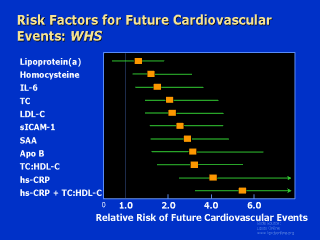 |
How
well does the CRP test compare with other novel and emerging risk factors for vascular
disease? This issue was directly addressed in the Women's Health Study, in this direct
comparison of ten putative risk factors for vascular disease. In each case, the point
estimate is based on being in the top versus bottom quartile for that particular analyte,
and the horizontal bars represent the 95% confidence intervals for that effect. Starting
from the top, we see that lipoprotein(a) screening was not a statistically significant
predictor of risk, and below that, homocysteine screening, while statistically
significant, was only of modest predictive value. This plot also indicates that the
predictive value for LDL cholesterol, while highly statistically significant, sits
approximately midway in terms of our overall risk prediction models. Interestingly, plasma
levels of soluble intercellular adhesion molecule 1 (ICAM-1), a molecular marker
associated with the adhesion and transmigration of leukocytes across the endothelial wall,
as well as serum amyloid A (SAA), a nonspecific marker of inflammation, were in fact
better markers of risk than was the LDL cholesterol or the total cholesterol level. Also
of note from a clinical perspective, the best lipid marker was the total cholesterol:HDL
cholesterol ratio. This finding is highly consistent with many prior epidemiologic studies
and in fact is why many preventive practices prefer to use the ratio rather than any
single lipid marker. However, the critical observation in this study was that plasma
levels of hs-CRP on their own were actually the single strongest predictor for future
vascular events, and those data are shown in the second line from the bottom. On its own,
hs-CRP screening was associated with a 4.4-fold increase in risk for future vascular
events among these otherwise healthy, middle-aged women. But again, the important issue is
to consider combining the inflammatory screening with the lipid screening, and that is
shown in the bottom line of data on the slide, suggesting that the combination of CRP
level with total cholesterol: HDL cholesterol ratio provides the best overall risk
estimate. Reference:
Ridker PM, Hennekens CH, Buring JE, Rifai N. C-reactive protein and other markers of
inflammation in the prediction of cardiovascular disease in women. N Engl J Med
2000;342:836-843.
WebsiteRidker PM et al. N Engl J Med 2000;342:836-843. |
